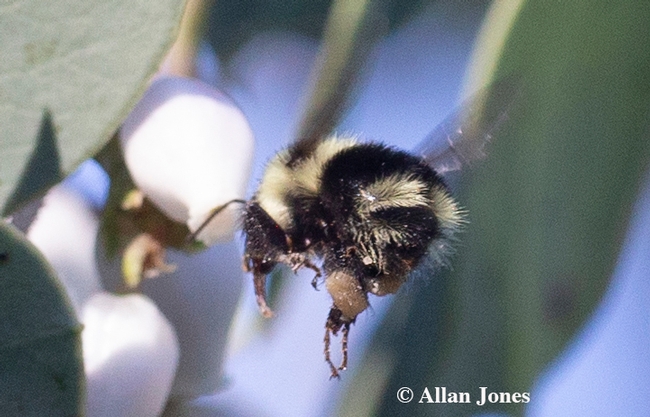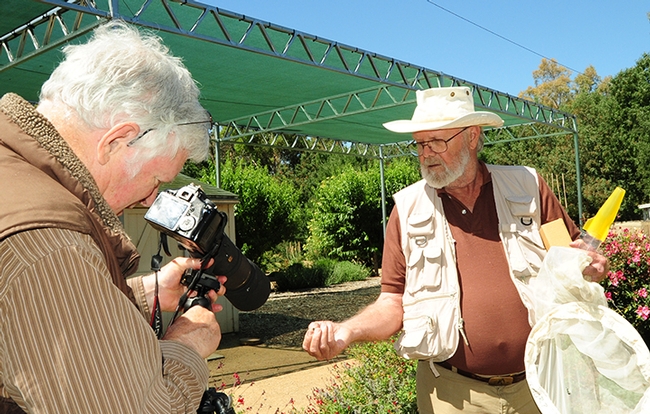- Author: Kathy Keatley Garvey
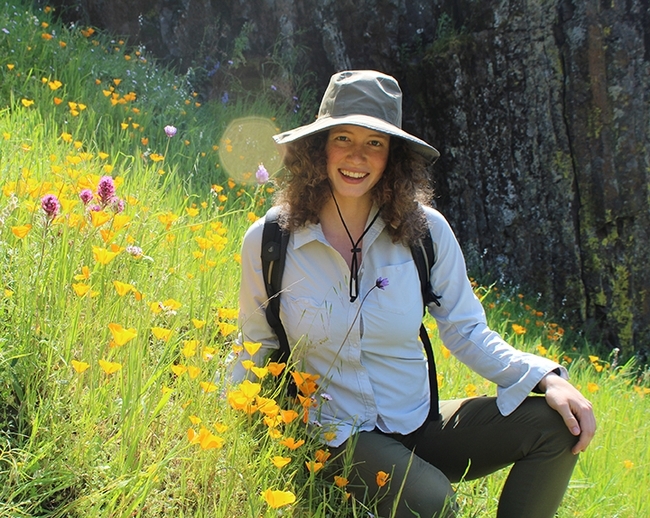
The open-to-the-public competition involved searching for the first-of-the-year bumble bee in the two-county area of Yolo or Solano; photographing it; and emailing the image to the Bohart Museum at bmuseum@ucdavis.edu.
The first bumble bee to emerge in this area is usually the black-tailed bumble bee, Bombus melanopygus, but another bumble bee, the yellow-faced bumble bee, Bombus vosnesenskii,is out early as well.
Both are considered "spring bees" because that is when their population is the highest, according to Thorp. Then their numbers "tail" the rest of the year.
Lynn Kimsey, director of the Bohart and a UC Davis distinguished professor, Department of Entomology and Nematology, announced Saturday that "we have the winners."
Not one winner, but two. No one species, but two.
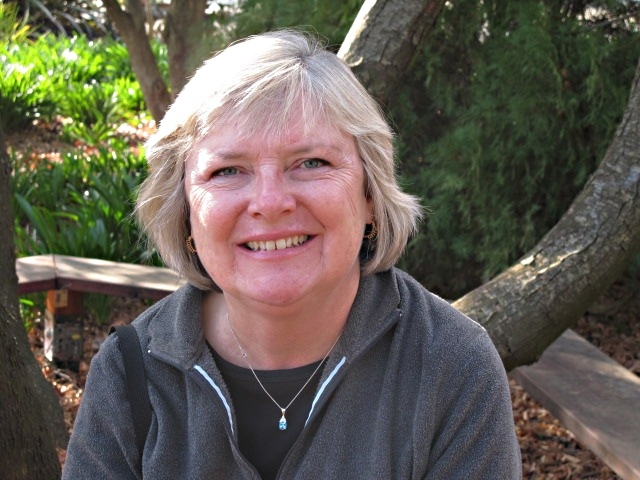
Coincidentally, they each took their photos at exactly 2:30 p.m., Jan. 1 in the 100-acre UC Davis Arboretum and Public Garden as the bees foraged on manzanita.
And fittingly, they both knew and worked with Robbin Thorp (1933-2019), a global authority on bees and a UC Davis distinguished emeritus professor of entomology.
The event also marked the second consecutive year that a member of the Williams lab won. Last year postdoctoral researcher Charlie Casey Nicholson of the Williams lab and the lab of Elina Lastro Niño, claimed the prize by photographing a B. melanopygus at 3:10 p.m., Jan. 14 in a manzanita patch in the Arboretum.
As the 2022 winners, Page and Zagory will each receive a coffee cup designed with the endangered Franklin's bumble bee, a bee that Thorp closely monitored in its small range at the California-Oregon border. The cup features the image of the bee specimen, photographed by Bohart scientist Brennen Dyer, and designed by UC Davis doctoral alumnus Fran Keller, professor at Folsom Lake College.
The television program, Good Day Sacramento, featured the contest on Jan. 3. (See it here.)
Worldwide Collection. The Bohart Museum houses a worldwide collection of 8 million insect specimens, including 112 species of bumble bees, Kimsey said. Thorp spend much of his time at the Bohart where he identified bees and helped colleagues with their research.
Thorp, a 30-year member of the UC Davis faculty, retired in 1994 but continued his work on bees until his death at age 85 at his home in Davis. Known as a tireless advocate of pollinator species protection and conservation, he co-authored two books in 2014: Bumble Bees of North America: An Identification Guide (Princeton University) and California Bees and Blooms: A Guide for Gardeners and Naturalists (Heyday).
Said Zagory: “I indeed knew Robbin Thorp, one of the most generous and kind people I have ever met. Dr. Thorp invited me to do a page for their book (California Bees And Blooms: A Guide for Gardeners and Naturalists) about the UC Davis Arboretum All-Stars (pages 230 -232) and he edited a publication we created at the UC Davis Arboretum called Ten Bees and Ten Plants they Love that can be downloaded from the website at https://arboretum.ucdavis.edu/pollinator-gardening.
Page is a 2018 alumnus of The Bee Course, which Thorp co-taught from 2002-2018. The nine-day intensive workshop, geared for conservation biologists and pollination ecologists and considered the world's premiere native bee biology and taxonomic course, takes place annually in Portal, Ariz. at the Southwestern Research Station, part of the American Museum of Natural History, N.Y. (The 2021 winner--Charlie Casey Nicholson--is a 2015 alumnus of The Bee Course.)
Page said she was “also lucky enough to participate in a "Bumble Bee Blitz" organized by Thorp and the U. S. Fish and Wildlife Service in July 2016 on Mt. Ashland, where we searched for Bombus franklini and Bombus occidentalis-- two very rare West Coast bee species. We unfortunately did not find Bombus franklini, which is now recognized as an endangered species under the Endangered Species Act.”
Brilliant Scientist. “Robbin was a brilliant scientist and a dedicated advocate for bumble bee conservation,” Page said. “His death was a great loss and I wish more of my career could have overlapped with his time in Davis.”
As a doctoral candidate in entomology, Page researches and investigates “whether European honey bees compete with native bees for floral resources and how we can use well-planned floral enhancements to mitigate negative effects of competition."
How rare is it find Bombus vosnesenskii on Jan. 1?
In an email today, UC Davis doctoral alumnus and Thorp protégé Kim Chacon, said she has seen B. vosnesenskii near San Luis Obispo since Dec 26. She is a lecturer at California Polytechnic University (Cal Poly). "I think it is a very opportunistic species. In my research, that was one of the first emergers, the 6th genus actually. Robbin Thorp had an interesting theory about bumble bees dealing with a virus or other illness which was shifting the dominant species to vosnesenskii. I'm so happy both Ellen and Maureen won-- they are both awesome!"
"My congratulations, too," said bumble bee enthusiast/photographer Allan Jones of Davis, a friend of Thorp's. "I did not even go out considering the chilly weather. I expected it to be on the second day when we got up into the sixties, and with the ground so damp and cold, too. Hats off, brrrr."
Both bumble bee species have also been sighted and photographed in recent years on Dec. 31 and Jan. 1 in Benicia, Solano County.
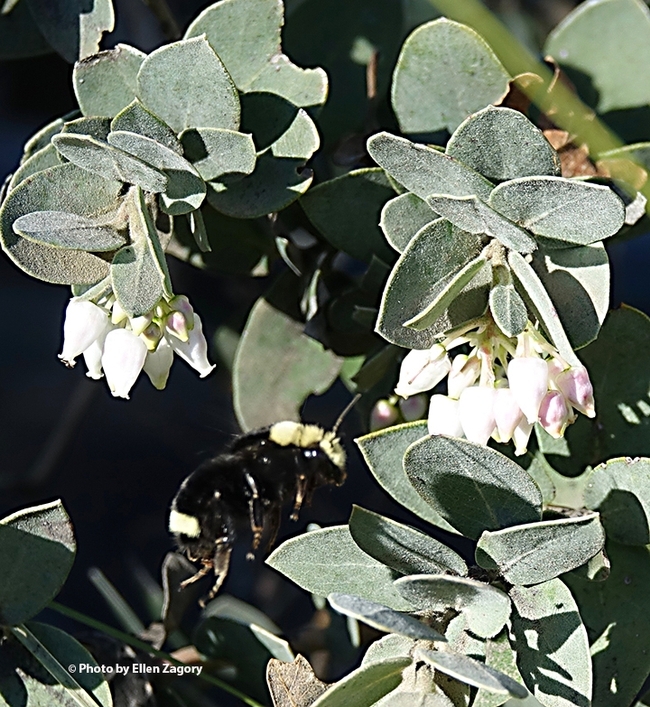
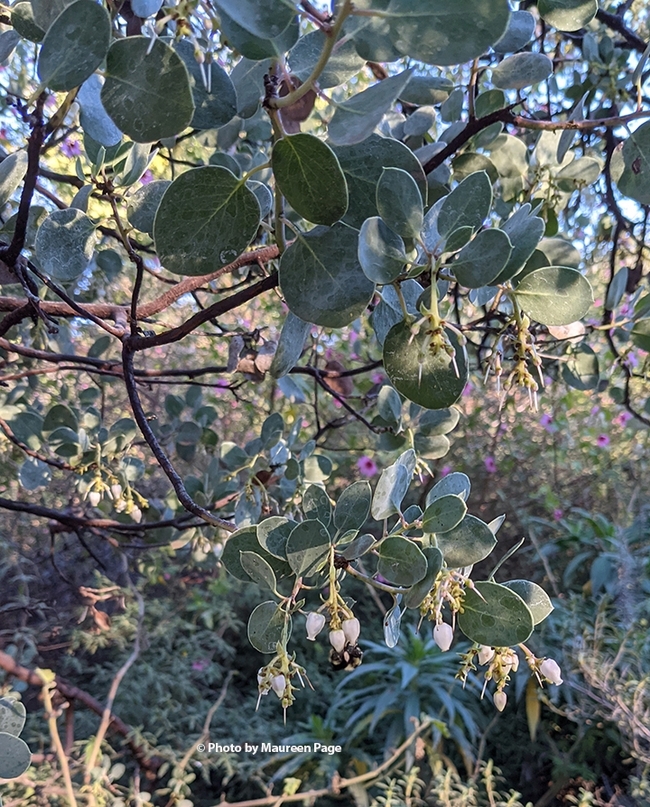
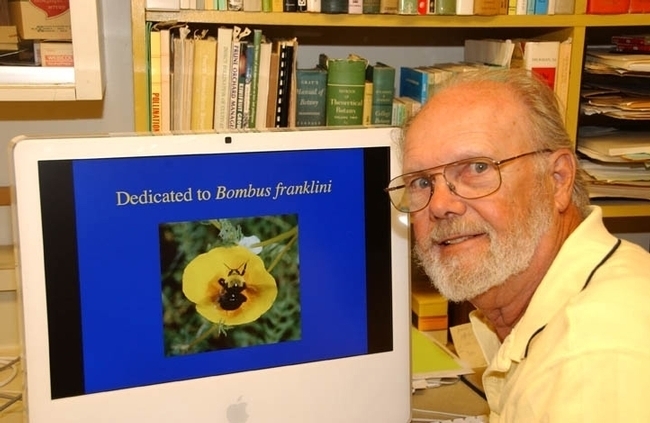
- Author: Kathy Keatley Garvey

Well, if your name is Allan Jones of Davis, Calif., and you capture images of insects throughout the year--especially at the 100-acre UC Davis Arboretum and Public Garden and the half-acre Häagen-Dazs Honey Bee Haven on Bee Biology Road--and you like to carve pumpkins as an art form, you know that insects and pumpkins go together. They go together very well.
Almost every year Jones carves fanciful pumpkins showcased in the Common Grounds coffee house at 2171 Cowell Blvd., Suite F. "So amazing!" said Tabatha Yang, education and outreach coordinator for the Bohart Museum of Entomology at UC Davis, who recently stopped by the coffee house and admired Jones' creations.
"They generally are based on some coffee-related theme," Jones related. "This year I drew on a photo that lingered in my mind of a praying mantis leaning around a sunflower to go shopping for bees. It's a trick or treat, or maybe a bad-things-brewing situation."
"So I've gone back and found the source photo and it is nothing like the pumpkin image I've conjured from memory. But the story is still pretty much on point with artistic liberties taken with insect and flower anatomy."
How he does it: "I 'surface carve' each pumpkin like a wood carving with a v-gouge, then color them. This way they last a month or more as coffee house decorations. Most are coffee-joke pumpkins but I also like to carve natural subjects for fun, too."
An alumnus of UC Davis, Allan became an Aggie in 1961, receiving degrees in English and German in 1966, and his master's in English in 1972. He joined the doctoral program in 1973 "but I quit in 1974, making my summer job of inspecting tomatoes my career for 43 seasons (with California Department of Food and Agriculture for half of my career and then working with CDFA on an independent advisory board). I did some workmanlike macro photography of tomato defects and wider shots of the inspection process for training.“
Allan spent the ‘70s in Dixon, and the ‘80s and ‘90s in Sacramento “before moving back to Davis after 2000.”
The UC Davis alumnus also created art with the UC Davis Art and Science Fusion Program, launched and directed by the duo of entomology professor Diane Ullman of the UC Davis Department of Entomology and Nematology, and self-described "rock artist" Donna Billick of Davis. Their campus and community projects are permanent displayed over much of the UC Davis campus, including the Arboretum and the UC Davis Department of Entomology and Nematology's bee garden, the Häagen-Dazs Honey Bee Haven.
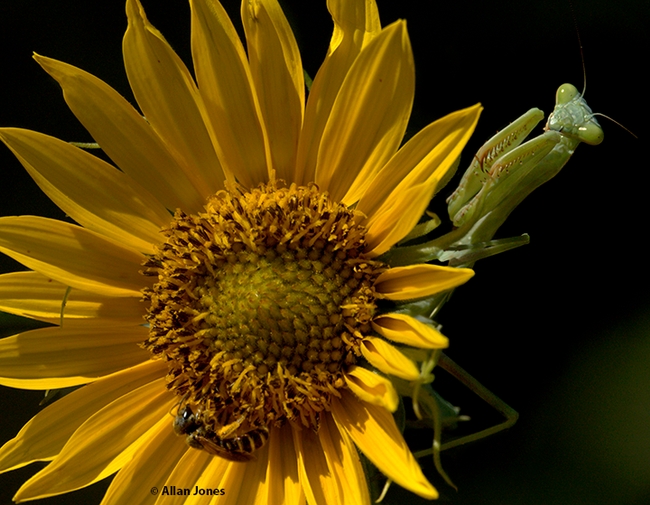
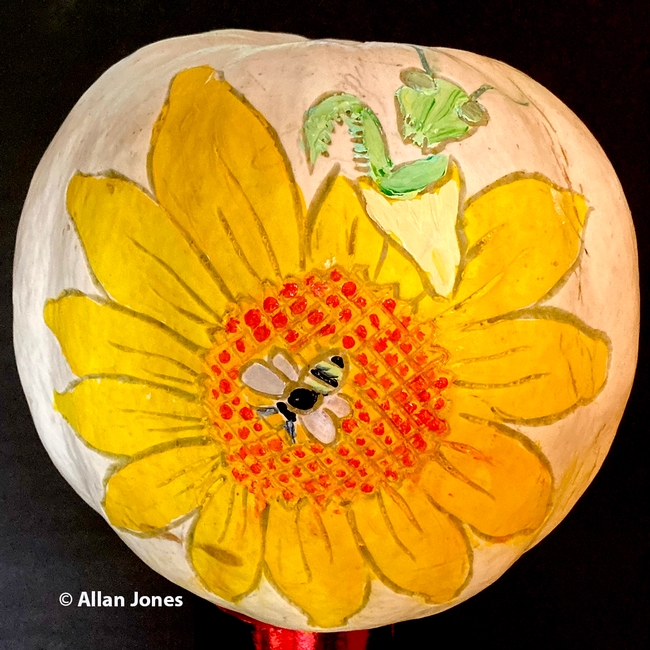
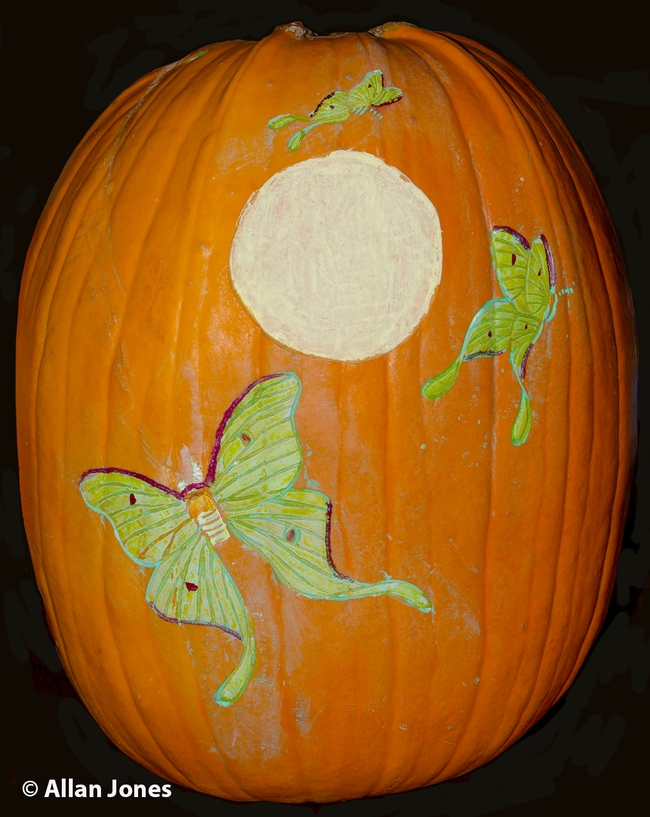
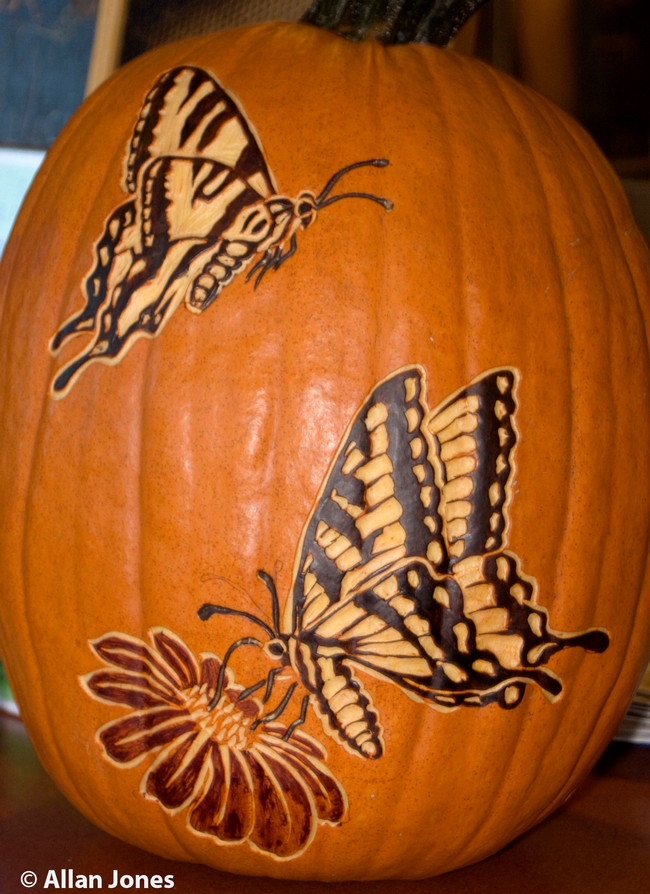
- Author: Kathy Keatley Garvey
Scientists say that within several weeks, trillions of cicadas from Brood X will emerge in 15 eastern-central states of our nation, from Georgia to New York.
These periodical circadas have spent the last 17 years underground feeding and growing, and growing and feeding and soon they will tunnel out and emerge together in what some call a "synchronous emergence."
Scientists will be delighted. The cicadas will call for mates; the squeamish will recoil at the numbers and sounds; and predators will eat their fill.
"Nearly 3,400 species of cicadas exist worldwide," according to a May 10th article in Scientific American. "But periodical cicadas that emerge en masse once every 17 or 13 years are unique to the eastern U.S. The 17-year cicadas live in the North, and the 13-year cicadas are found in the South and the Mississippi Valley. The three species of 17-year cicadas—Magicicada septendecim, M. cassinii and M. septendecula—form mixed-species cohorts called broods whose members arise like clockwork on the same schedule. The broods are identified by Roman numerals. Brood X is the largest of the 12 broods of 17-year cicadas, which emerge in different years."
Nature photographer Allan Jones of Davis says he expects "to hear quite a bit about cicadas emerging back East soon."
"I do not see cicadas often around here, but one flew by me several years ago in the Ruth Risdon Storer Garden (UC Davis Arboretum and Public Garden) and lit in the Ranger Sage." That was on June 7, 2011.
Community ecologist Louie Yang, associate professor, UC Davis Department of Entomology and Nematology (he goes by the name of "cicadachaser" on Twitter), commented: "I don't know the western cicadas well, but that appears to be Okanagana arboraria."
Yang recently (April 29) presented a seminar to Georgetown University's Biology Department on his research on cicada emergence as a resource pulse in local ecosystems.
California is home to some 65 species of cicadas. Worldwide, "there are more than 3,000 species of cicadas, which fall into roughly two categories: annual cicadas, which are spotted every year, and periodical cicadas, which spend most of their lives underground and only emerge once every decade or two, according to National Geographic.
The Bohart Museum of Entomology at UC Davis (temporarily closed due to the COVID-19 pandemic) has scores of cicada specimens, according to director Lynn Kimsey, UC Davis distinguished professor of entomology.
I have one. My mother, who grew up on a West Texas ranch, left one in her estate. She tucked it into a little box labeled "Texas bug." No one knows when or where she found it, but it measures two-and-a-half inches long and an inch wide.
What we do know is that the cicada is considered one of the world's loudest insects. "The chirping and clicking noises of the male cicada are actually a species-specific mating call that can be heard by females up to a mile (1.6 kilometers) away," according to LiveScience in its piece on "Why Do Cicacas Sing."
Wish we were there...
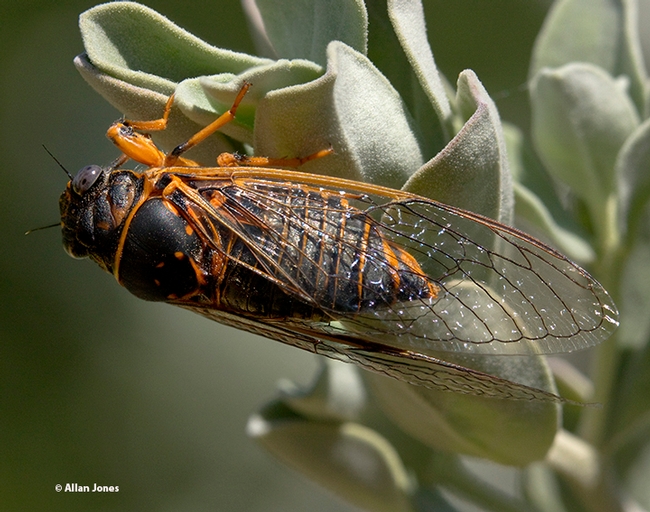
- Author: Kathy Keatley Garvey
Meanwhile, in between social distancing, what's happening in the world of insects?
We were surprised to see a skipper butterfly today (March 25) foraging in our bed of mustard in Vacaville, Calif.
Butterfly guru Art Shapiro, UC Davis distinguished professor of evolution and ecology, identified it as an "Umber Skipper, Poanes melane, a riparian species I haven't seen at any of my sites yet! It typically flies first in early to mid-April."
With thoughts of Shapiro's Beer-for-a-Butterfly Contest (first person who collects the first-of-the-year cabbage white butterfly in the three-county area of Sacramento, Solano and Yolo wins a pitcher of beer or its equivalent), I mentioned that I finally beat him!
"I'd say go get a beer, but the bars are closed," Shapiro quipped. "Last year's first records of melane were very late (first iv.24) , as were 2018 (first v.10!). In the East Bay it usually comes out around now. Are you sure you weren't in North Berkeley? At Gates Canyon (Vacaville), my earliest is iii.26.88, which is my earliest anywhere on my transect! During the drought it was fairly early--iv.15.14 and iv.10.15."
Shapiro writes on his website: "Although common in parts of the Bay Area where it is an urban 'lawn skipper,' on our transect this is entirely a species of riparian forest and is generally uncommon or even rare. It perches in dappled light and shade along streamsides, generally well off the ground. Its upper limit of residency at the latitude of I-80 seems to be about 3000'. There is no evident variation. Two to three broods in our area, April-October; flight season longer in Bay Area. Host plants presumably native riparian grasses, but not identified. In Berkeley, it breeds happily on Bermuda Grass, which seems to have not discovered farther inland. Adults visit Yerba Santa, Dogbane, Milkweed, Thistles, Yellow Star Thistle, California Buckeye, Coyote Brush, etc., etc."
Shapiro has monitored butterfly population trends on a transect across central California since 1972 and maintains a research website. The 10 sites stretch from the Sacramento River Delta through the Sacramento Valley and Sierra Nevada mountains to the high desert of the Western Great Basin. The largest and oldest database in North America, it was recently cited by British conservation biologist Chris Thomas in a worldwide study of insect biomass.
And then another surprise! My photographer-naturalist friend, Allan Jones of Davis, captured some images of an Anise Swallowtail (Papilio zelicaon) Saturday, March 21 in the UC Davis Department of Entomology and Nematology's Häagen-Dazs Honey Bee Haven, a half-acre bee garden on Bee Biology Road, west of the central campus. Jones also saw a bumble bee, Bombus melanopygus (female), and a first-of-the-season Eucera frater (male) in the haven.
Said Shapiro: "Zelicaon has been rare hereabouts for about 20 years. It is not unusual to see it the 3rd week of February in dry years. It's been earlier than average this year: Suisun Marsh, iii.26; Old Davis Road (near Low-Water Bridge) ii.28; Gates Canyon (near Vacaville) ii.29, North Sacramento iii.3, Rancho Cordova iii.4."
Meanwhile, back to social distancing!
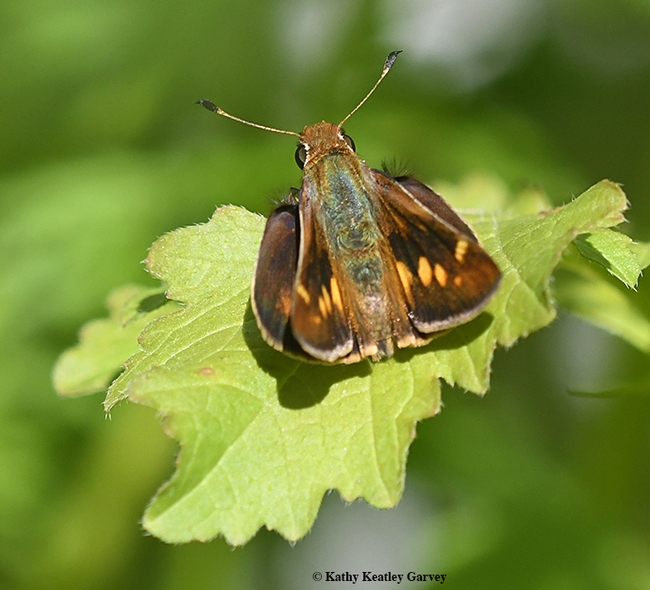
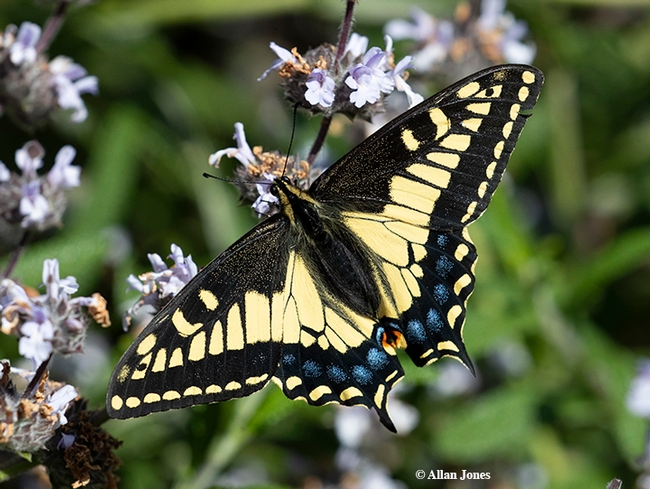
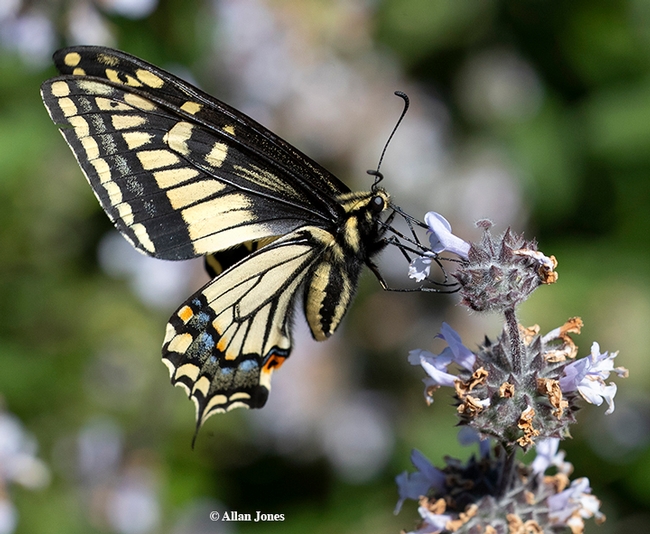
- Author: Kathy Keatley Garvey

Macro insect photographer extraordinaire Allan Jones captured an image of a female black-tailed bumble bee, Bombus melanopygus on Monday, Jan. 6 on the UC Davis campus.
- The time: 1:45 p.m.
- The place: On white manzanita, just east of the 0ld Redwood Grove past the Old Davis Road/Arboretum Drive entrance, UC Davis Arboretum and Public Garden
- The temperature: About 56 degrees
"From the looks of her pollen load, she has been out collecting for some time now, so she must have been collecting earlier when it was colder yet," Jones reported. He saw one yesterday (Jan. 5 in Davis) west of El Macero but the bumble bee flew before he could photograph it. "I figured the black-tail ground nests were warmed up enough so they would be out early."
Jones, who worked closely with global bumble bee authority Robbin Thorp (1933-2019), distinguished professor of entomology at UC Davis, explained the warming of the nests:
"One summer while shooting bees soon after dawn at a lavender farm in the foothills, the first flight of bees were the bumble bees. Once it warmed up some, the honey bees showed up. So a few years ago I asked Robbin why on chill winter days I was seeing lots of honey bees, but no bumble bees. (Of course I was eager to win our contest.)
"He explained that bumble bees often nest facing north so that in cold mountainous climates, the warm southern sunshine does not warm their nests and lure them into a sudden drop in temperature or a snow squall that would kill them. Instead they wait for the ground and their nest to warm a bit before they venture out. It was Robbin's reasoning that lead me to believe that yesterday's B. melanopygus sighting in South Davis proved that local nests were warm enough that they would be flying with honey bees in the low '50s. A few years ago, the winner went out and got a shot on a day with very low temperatures as well, but she was on campus where buildings produce some tropical microclimates. This year I decided to get out early."
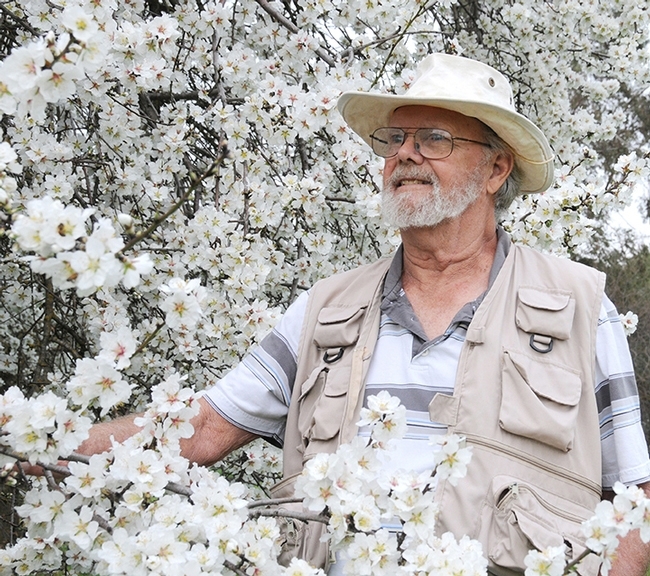
The Contest
A little bit about the contest: Thorp launched the contest in 2012 with a small group of bumble bee enthusiasts/photographers: Allan Jones and Gary Zamzow of Yolo County, and yours truly of Solano County. Later UC Davis doctoral student Kim Chacon with the Geography Graduate Group (and on track to receive her doctorate in June 2020), joined the group. Chacon, who studies "habitat connectivity issues for bees at a landscape scale" (see her website on Resilient Bee Landscapes), worked closely with Thorp until his death in June 2019. She is a 2018 alumnus of The Bee Course, co-taught by Thorp.
The rules are simple: the first one who photographs the first bumble bee of the year in Yolo or Solano County wins the title! (No reward, just bragging rights)
The Bee
The first bumble bee to emerge in this area is the black-tailed bumble bee, Bombus melanopygus. Native to western North America and found from California to British Columbia and as far east as Idaho, it forages on manzanitas, wild lilacs, wild buckwheats, lupines, penstemons, clovers, and sages, among others.
Thorp, a member of the UC Davis entomology faculty for 30 years, from 1964-1994, achieved emeritus status in 1994 but continued to engage in research, teaching and public service until a few weeks before his death. In 2014, during his retirement, he co-authored two books, Bumble Bees of North America: An Identification Guide and California Bees and Blooms: A Guide for Gardeners and Naturalists. He co-taught The Bee Course from 2002 to 2019. This is an intensive nine-day workshop affiliated with the American Museum of Natural History and held annually at the Southwestern Research Station, Portal, Ariz. It's geared for conservation biologists, pollination ecologists, and other biologists who want to gain greater knowledge of the systematics and biology of bees.
The Arboretum
The 100-acre UC Davis Arboretum and Public Garden, spanning the 5300-acre campus, is a landmark on the UC Davis campus--and traces its beginnings to more than 80 years ago. As the website says, it includes "demonstration gardens and scientific collections as well as the Putah Creek Riparian Reserve – a rare stream and grassland ecosystem managed for teaching, research, wildlife and habitat protection."
Go visit the Arboretum--and be sure to look for the bumble bees!
